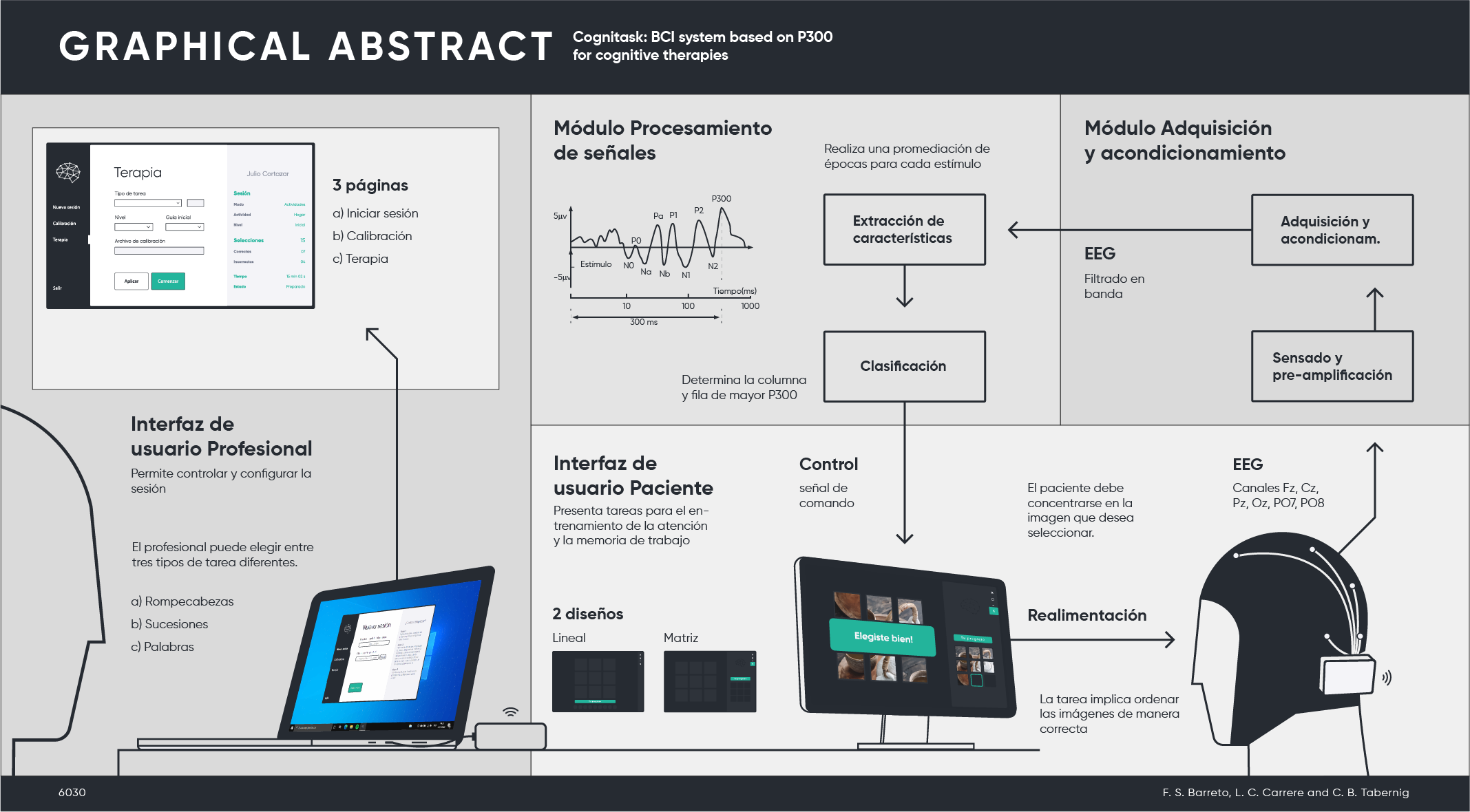Cognitask: BCI system based on P300 for cognitive therapies
Keywords:
attention, brain-computer interface, cognitive therapy, p300, working memory, BCI2000, PythonAbstract
Brain-computer interfaces can be used within a therapy rehabilitation of cognitive functions such as attention and working memory. This paper presents the design, implementation and preliminary evaluation of Cognitask, a BCI for cognitive rehabilitation. It consists of a modified version of the P300-based speller BCI that allows the presentation of different cognitive tasks. During a task, the patient must complete a certain pattern by ordering a set of images presented disorderly in a visual stimulation matrix. The selection of each image is recognized using the P300 elicited when the patient looks at the matrix where images are flashing and selects one by attending to it. Cognitask consists of four modules. The first acquires and conditions the electroencephalography signal from six electrodes positioned at the fronto-central and parieto-occipital regions. The second processes the signals and translates them into a control signal. The third consists of a user-interface that presents the cognitive task to the patient. The last module consists of a graphical interface for the professional that allows configuration of the session parameters. Two evaluations of Cognitask were performed. The first evaluated the operational functioning of the system using input signals generated by a software. The second evaluated the performance of the system in three healthy volunteers. The results showed that Cognitask had a correct functioning and a maximum average success rate of 92%. These results suggest that Cognitask can be transferred to the clinical setting for evaluation in adults with cognitive deficits.
Downloads
References
R. Pais, L. Ruano, O. P. Carvalho, and H. Barros, “Global cognitive impairment prevalence and incidence in community dwelling older adults—a systematic review,” Geriatrics (Switzerland), vol. 5, no. 4. MDPI AG, pp. 1–16, Dec. 01, 2020.
C. Zurique Sánchez et al., “Prevalence of dementia in the elderly in Latin America: A systematic review,” Revista Espanola de Geriatria y Gerontologia, vol. 54, no. 6. Ediciones Doyma, S.L., pp. 346–355, Nov. 01, 2019.
M. Ordikhani-Seyedlar and M.A. Lebedev, “Controlling attention with neurofeedback”. In The Physics of the Mind and Brain Disorders, Springer, Cham, pp. 545-572, 2017.
B. Zoefel, R. J. Huster, and C. S. Herrmann, “Neurofeedback training of the upper alpha frequency band in EEG improves cognitive performance”. NeuroImage, vol. 54(2), pp. 1427–1431, 2011.
J. R. Wolpaw, J. del R. Millán, and N. F. Ramsey, “Brain-computer interfaces: Definitions and principles,” Handb. Clin. Neurol., vol. 168, pp. 15–23, 2020.
M. Ordikhani-Seyedlar, M. A. Lebedev, H. B. D. Sorensen, and S. Puthusserypady, “Neurofeedback therapy for enhancing visual attention: State-of-the-art and challenges,” Front. Neurosci., vol. 10, no. AUG, 2016.
E. W. Sellers, Y. Arbel, and E. Donchin, “BCIs That Use P300 Event-Related Potentials,” Brain-Computer Interfaces Princ. Pract., May 2012.
M. Arvaneh, I. H. Robertson, and T. E. Ward, “A P300-Based Brain-Computer Interface for Improving Attention,” Front. Hum. Neurosci., vol. 12, Jan. 2019.
L. A. Farwell and E. Donchin, “Talking off the top of your head: toward a mental prosthesis utilizing event-related brain potentials,” Electroencephalogr. Clin. Neurophysiol., vol. 70, no. 6, pp. 510–523, 1988.
E. W. Sellers, D. J. Krusienski, D. J. McFarland, T. M. Vaughan, and J. R. Wolpaw, “A P300 event-related potential brain-computer interface (BCI): The effects of matrix size and inter stimulus interval on performance,” Biol. Psychol., vol. 73, no. 3, pp. 242–252, 2006.
G. Pires, M. Torres, N. Casaleiro, U. Nunes, and M. Castelo-Branco, “Playing Tetris with non-invasive BCI,” 2011 IEEE 1st Int. Conf. Serious Games Appl. Heal. SeGAH 2011, 2011.
A. Y. Kaplan, S. L. Shishkin, I. P. Ganin, I. A. Basyul, and A. Y. Zhigalov, “Adapting the P300-based brain-computer interface for gaming: A review,” IEEE Trans. Comput. Intell. AI Games, vol. 5, no. 2, pp. 141–149, 2013.
J. I. Münßinger et al., “Brain painting: First evaluation of a new brain-computer interface application with ALS-patients and healthy volunteers,” Front. Neurosci., vol. 4, no. NOV, 2010.
E. Donchin and M. G. H. Coles, “Is the P300 component a manifestation of context updating?,” Behav. Brain Sci., vol. 11, no. 3, pp. 357–374, 1988.
M. Kutas, G. Mccarthy, and E. Donchin, “Augmenting mental chronometry: The p300 as a measure of stimulus evaluation time,” Science (80-. )., vol. 197, no. 4305, pp. 792–795, 1977.
P. Cipresso et al., “The use of P300-based BCIs in amyotrophic lateral sclerosis: From augmentative and alternative communication to cognitive assessment,” Brain Behav., vol. 2, no. 4, pp. 479–498, Jul. 2012.
R. Dinteren, M. Arns, M. L. A. Jongsma, and R. P. C. Kessels, “P300 development across the lifespan: A systematic review and meta-analysis,” PLoS One, vol. 9, no. 2, Feb. 2014.
M. Zwecker, I. Sarova, M. Lavie, G. Zeilig, and A. Achiron, “Detection of Cognitive Impairment in Multiple Sclerosis Based on P300 Event-Related Potential,” Int. J. Phys. Med. Rehabil., vol. 06, no. 04, 2018.
S. Jiang et al., “Using event-related potential P300 as an electrophysiological marker for differential diagnosis and to predict the progression of mild cognitive impairment: a meta-analysis,” Neurol. Sci., vol. 36, no. 7, pp. 1105–1112, Jul. 2015.
“BCI2000 Wiki.” https://www.bci2000.org (accessed Jul. 20, 2021).
D. J. Krusienski, E. W. Sellers, D. J. McFarland, T. M. Vaughan, and J. R. Wolpaw, “Toward enhanced P300 speller performance,” J. Neurosci. Methods, vol. 167, no. 1, pp. 15–21, 2008.
R. C. Acevedo, G. G.Gentiletti, J. A. Aldonate, Y. V.Atum, J. B.Manresa, , C. E. Bonell,., ... & M. A. Richard, “Técnicas para Detección y Estimación Eficiente de Potenciales Evocados”. Ciencia, Docencia y Tecnología Suplemento, vol. 8, no. 8, Dec. 2018
D. J. Krusienski et al., “A comparison of classification techniques for the P300 Speller,” J. Neural Eng., vol. 3, no. 4, Dec. 2006.
“g.NAUTILUS RESEARCH | Wearable EEG Headset | g.tec medical engineering GmbH.” https://www.gtec.at/product/gnautilus-research/ (accessed Jul. 20, 2021).
F. Barreto, "Desarrollo de una BCI para rehabilitación cognitive en adultos con deficit de atención," tesis de grado, Universidad Nacional de Entre Ríos, Oro Verde, Argentina, 2021.


